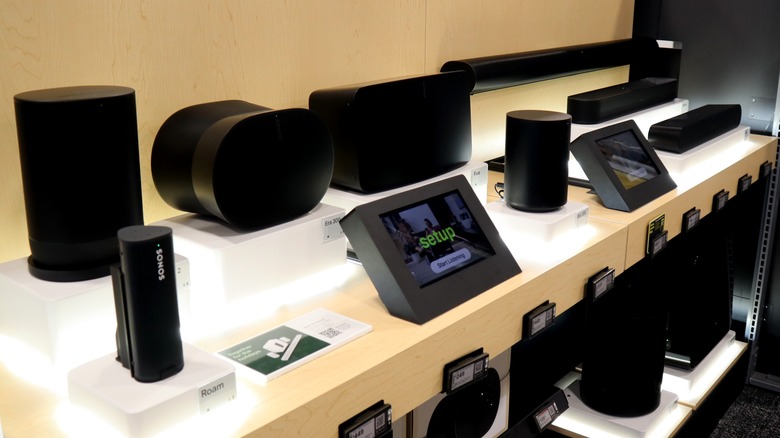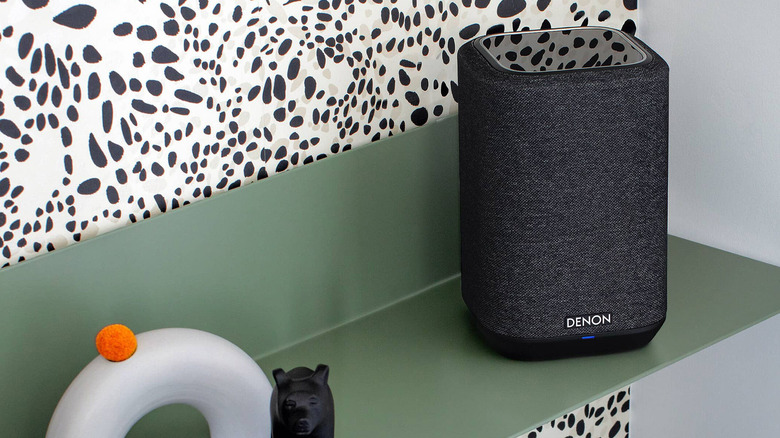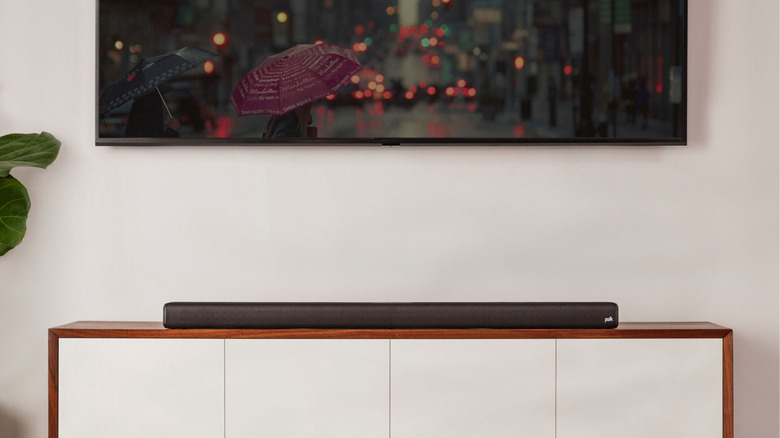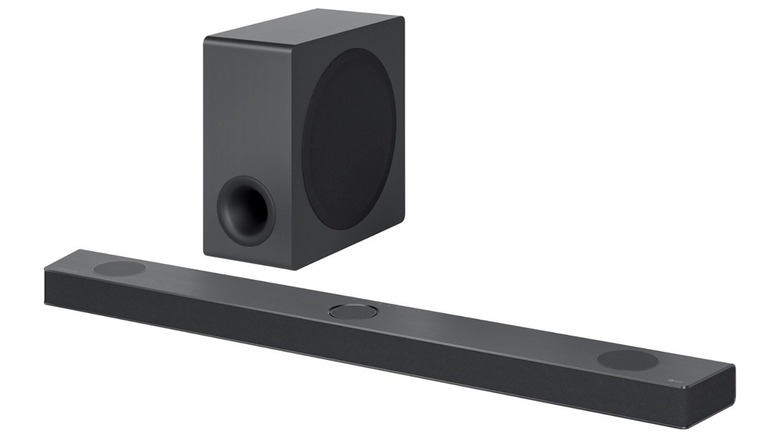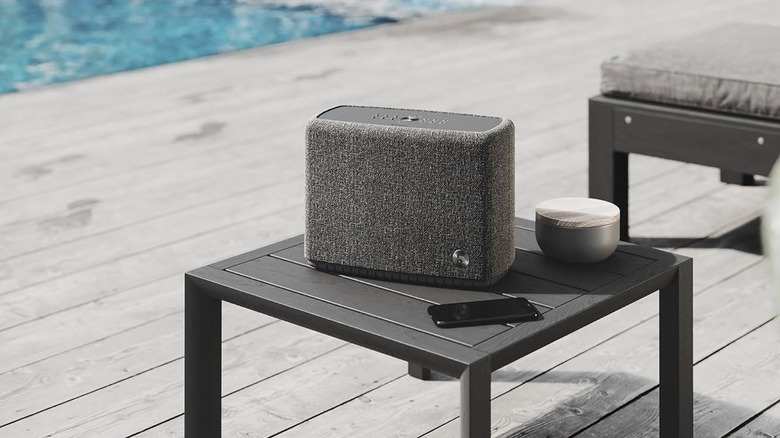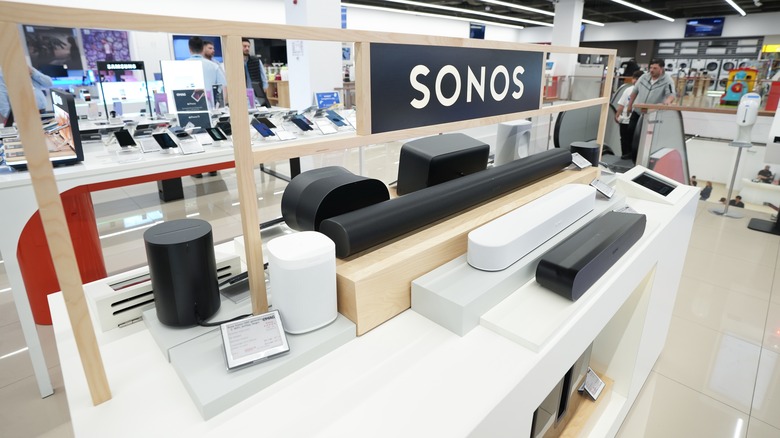4 Budget-Friendly Sonos Alternatives For Your Home Or Workspace
We may receive a commission on purchases made from links.
When it comes to home audio products, one brand that has become synonymous with high quality is Sonos. Originally best known for its seamless, wireless whole home and multi-room music-streaming functionality in its core products, its wares have expanded in recent years to include portable Bluetooth speakers and soundbars for home theaters. Sonos' price points also run the gamut, starting at pretty affordable, given the sound quality and feature set, but getting further out of reach of the average person with items like the $899 MSRP Sonos Arc soundbar and the $799 MSRP Sonos Sub wireless subwoofer.
With that in mind, there's going to be a demand for less expensive alternatives to the various products across the Sonos product line. In some cases, that's easier said than done, with some of Sonos' most direct competitors aiming to put out similar products at similar price points. With other broader product categories, however, finding more affordable alternatives to some of Sonos' speaker products is a lot easier, so let's take a look at a few of those alternatives that will impact your wallet a lot less.
For multi-room and whole-home audio, there's not much price competition
When it comes to Sonos' signature feature set — seamless, wireless playback in various rooms throughout your home and the ability to pair identical speakers for a wider stereo image — the competition is generally not trying to undercut Sonos. Instead, they're looking to provide alternative feature sets and a pledge of superior sound quality as their way of cutting into Sonos' market share.
Take, for example, Denon's Home line of wireless speakers that use its HEOS ecosystem. It's less in sync with Sonos' offerings than it used to be since Sonos' last refresh, but it still follows a very recognizable tiering system. The Home 150 mono speaker retails for $249 ($219 for the Home 150 NV, which removes the smart speaker microphones), while the stereo Home 250 retails for $499 and the bigger stereo model, the Home 350, retails for $699. It's basically Denon's version of the old Sonos One/Play:1, Three/Play:3, and Five/Play:5 tiering model.
Denon's differentiator is its high-resolution digital to analog converter supporting FLAC, ALAC, and WAV files up to 24-bit/192kHz and DSD files in SACD quality (2.8MHz) and double-rate DSD (5.6MHz), while Sonos maxes out at 24-bit/48kHz. If you're looking for hi-res support, then that's a good reason to go with a Sonos alternative, with Yamaha's MusicCast being another potential option. Both companies also support their respective ecosystems on their AV receivers, making them more flexible than Sonos, as well.
Polk Signa S4 Soundbar
When it comes to alternatives to Sonos' Beam and Arc soundbars, what provides the best value at lower price points depends on what you're looking for. If you just want louder, clearer audio than your TV can provide, you're probably not eyeing anything close to the $499 MSRP that the Beam carries, much less the Arc's $899 MSRP. Realistically, you're probably looking for good surround sound virtualization and at least above-average music performance. By those metrics, Polk's Signa S4 soundbar with wireless subwoofer is probably one of the better buys available. It retails for $399, but is often on sale for $299 or less.
The big differentiator for the Signa S4, particularly in this price range, is that even before you get into using digital signal processing for virtual surround sound tricks, it packs in more — and more varied — speakers than a lot of its competition, including the Sonos Beam. The S4 is a 3.1.2 channel system, meaning the bar has three front-firing channels (left, right, and center) and two up-firing channels (left height and right height) buoyed by the sub for optimal bass performance.
In this price range, most soundbars lack up-firing speakers and offload the Dolby Atmos and DTS:X height effects to virtualization. The S4 has been widely reviewed by professionals and the results have been glowing with Wired, Trusted Reviews, and Digital Trends in particular all awarding it their respective recommendation badges. Its one big fault is it lacks Wi-Fi, which is odd since the lower-tier Signa S3 has it, complete with Chromecast.
LG S90QY Soundbar
Finding something that can be called a more affordable alternative to the Sonos Arc is trickier than it is with the Beam, as there's a broader feature set — like seven channels of speakers in a 5.0.2 channel configuration — that's harder to equal or beat at lower price points. It's still possible, though. LG offers up strong competition in the S90QY soundbar and wireless subwoofer combo, which is a 5.1.3 channel setup. It retails for $799.99, about $100 less than the Arc, but its street price is a good bit lower, usually hovering around $450 to $550 in the six-month period before the writing of this article.
Like the Arc, it's pumping out a lot of discrete channels of audio, but it adds a center height channel and a subwoofer to paint a bit of a fuller soundscape even before virtual surround sound DSP effects are introduced. And though it doesn't have the multi-room functionality of the Sonos ecosystem and its direct competitors like Denon HEOS, it does include all of the other key Wi-Fi options you'd hope for: Google Chromecast, Apple AirPlay 2, and Spotify Connect. It also has better hi-res support than Sonos (albeit inferior to Denon or Yamaha), going up to 24-bit/96kHz.
The most prominent professional review of the S90QY comes from RTINGS, which was very positive, giving it a 7.8 out of 10 score for mixed usage. If you have an LG TV from 2022 or later, that's another reason to consider this one, as many of the newer TVs have automated calibration features that work well with the S90QY.
Audio Pro A15 portable Bluetooth speaker
In 2019, Sonos expanded its lineup to include portable Bluetooth speakers — that had full Sonos functionality on your home Wi-Fi — with the introduction of the Sonos Move. These days, the Move 2 is the bigger and more premium ($449 MSRP) version of Sonos' portable speakers, while the Sonos Roam 2 is the smaller, less expensive ($179 MSRP) version, which was originally introduced in 2021. The best alternative to the Move 2 appears to be the Audio Pro A15 at $199 MSRP. Audio Pro is a Swedish company that offers up its own whole-home app ecosystem, which the A15 can be a part of on top of its battery-operated portable Bluetooth speaker functionality.
The available professional reviews for the A15 are pretty stellar. T3 gave the speaker a rating of 5 out of 5 stars and its Platinum Award recommendation badge, calling it "a portable multiroom speaker that sounds just as good as it looks." LB Tech Reviews, meanwhile, gave it 6 out of 6 stars, praising the A15's "rich and warm sound," with strong performance across bass, treble, and midrange frequencies. Overall, the Audio Pro A15 appears to be about as on the nose a direct competitor as you could hope for, attempting to meet the Sonos Move 2 as closely as possible on features while undercutting its price point significantly.
Bose SoundLink Micro portable Bluetooth speaker
Finding an alternative to the Sonos Roam is dependent on what features you're trying to copy and how far you're looking to go below its price point. Audio Pro has the Addon C3 as its only portable multi-room speaker besides the A15, for example, but it doesn't come close to emulating the form factor of the Roam, which is small enough for most adults to hold in one hand. The competitor that ticks the most boxes, then, while also coming in at a lower price, would be the Bose SoundLink Micro, which retails for $119 but is often on sale for $100 or less. (Yes, in this specific instance, it made sense to put a Bose product on a "budget-friendly" list.)
Not only is it a well-regarded hyper-portable Bluetooth speaker, but despite not having Wi-Fi functionality, the SoundLink Micro still manages to offer limited multi-room and stereo pairing functionality similar to that of Sonos-style speakers. Oh, and it's got an IP67 rating, meaning it's dust-tight and protected from being submersed in water for 30 minutes at a depth of one meter.
Professional reviews of the Bose SoundLink Micro are very positive, generally reflecting a consensus that it sounds bigger than it looks and is incredibly durable. PCMag gave it a 4 out of 5 rating, calling it "certainly one of the better-sounding speakers we've tested in its size category." TechHive gave it the same score, as did Trusted Reviews and (effectively) CNET, which gave it an 8.3 out of 10.
Methodology
Tackling this was tricky at first, because the products that are designed to compete with Sonos speakers with their signature multi-room and whole home functionality are not priced to undercut Sonos at all. At each tier — mono speaker, small stereo speaker, and larger stereo speaker — you can expect to pay a comparable price to what you'd pay for the Sonos equivalent. Even Audio Pro, which undercut the portable Sonos speakers, prices its Sonos Era 100 counterpart, the A10 MKII, at the same $249 MSRP. As a result, we couldn't provide any explicit "budget-friendly alternatives," though the additional features of some competitors, like hi-res support, may make them a better value for some consumers.
For the soundbars and portable speakers, we mined professional reviews to find a consensus on the quality of each speaker. Most of these are high-profile enough that the reviews weren't difficult to find. When applicable, speakers that appeared on a list of Sonos alternatives on a site that does professional reviews also helped, and what was pointed us in the direction of the Audio Pro A15 as a fully featured Sonos Move 2 alternative as opposed to just another portable Bluetooth speaker. With the Bose SoundLink Micro, the fact that the writer of this article owns a different SoundLink speaker (the seemingly discontinued SoundLink Color II) pointed us in the direction of its surprising multi-room functionality. So, with the SoundLink Micro being suitably tiny as a Roam competitor and well-reviewed, it made a lot of sense for it to close out this list.
